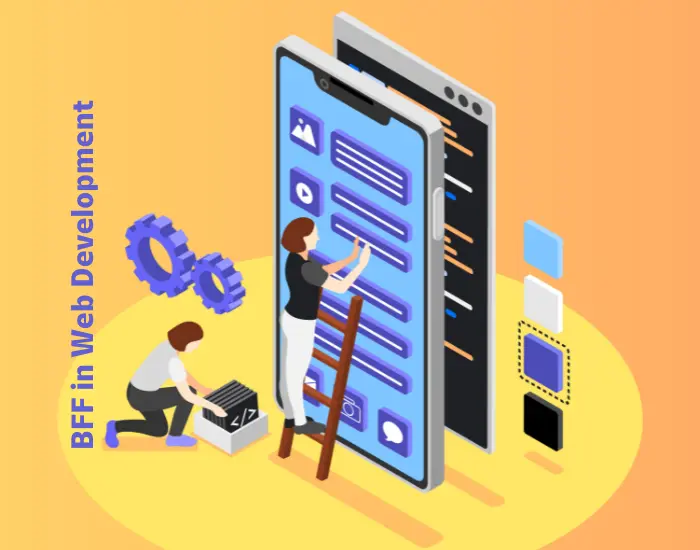Introduction
Suppose you’re planning a huge dinner party. You’ve got a fantastic menu planned, but your guests have different dietary needs and preferences. Do you make everyone wait while you prepare individual plates? Of course not! You’d assign tasks, ensuring vegetarians get their veggie delights while meat-lovers get their fill.
In web development, the “dinner party” is your complex web application, and the “guests” are your diverse frontends – web, mobile, and beyond. This is where BFF (Backend for Frontend) pattern comes in.
What is BFF in Web Development?
In web development, there’s a design pattern known as BFF, which stands for Backend for Frontend. This pattern is all about creating unique backend services that are specifically designed to meet the needs of individual front-end applications.
Here’s a simplified step-by-step process of how it works:
- The frontend of an application makes a request for data, which is directed to an API in the BFF.
- The BFF then communicates with the relevant microservices APIs to gather the necessary data.
- Once the data is obtained, the BFF takes on the task of formatting this data to match the specific needs of the frontend.
- Finally, this tailored data is sent back to the frontend.
The beauty of the BFF pattern lies in its ability to streamline the data representation process. It takes on the responsibility of providing a focused interface for the frontend, reducing the amount of logic that needs to be handled on the frontend side.
Moreover, the BFF pattern enhances the user experience significantly. It allows for intelligent batching of calls to other backends or microservices and returns the data all at once, or in a more convenient format by transforming and formatting the data. This is particularly beneficial for mobile clients on slower networks, where establishing a connection can take several seconds.
Furthermore, the BFF pattern provides a means to separate the backend and frontend, which can lead to quicker product releases as frontend teams can have dedicated backend teams catering to their unique needs. This also means that the release of new features on one frontend does not impact others, and APIs can be maintained, modified, and even versioned for specific frontends with greater ease.
Why BFF?
The adoption of BFF has surged in recent years, and for good reason. Here’s why it is beneficial:
Suppose your web application has a complex backend API that returns a massive dataset. Now, consider a mobile app that only needs a specific subset of that data to function. A traditional approach would require the mobile app to download the entire dataset which leads to slow performance and unnecessary data transfer. BFF intercepts the request, retrieves only the relevant data from the backend, and sends it directly to the mobile app. This significantly reduces data transfer and streamlines communication, resulting in a faster and more responsive user experience on all platforms.
Gone are the days of one-size-fits-all functionality. BFF lets you customize data, features, and functionalities to the specific requirements of each frontend. Need a simplified dashboard for your mobile app while offering a feature-rich experience on the web platform? BFF allows you to create the perfect data presentation and functionality for each individual frontend, leading to a more engaging and intuitive user experience across the board.
By offloading backend complexities to the BFF layer, frontend developers gain the freedom to focus on what they do best: creating beautiful, interactive user interfaces. It’s like having a dedicated backend team handle all the database calls and API interactions, while frontend developers concentrate on building a user-centric interface – a true win-win situation.
The BFF pattern seamlessly integrates with microservice architectures. In a microservice environment, the backend is divided into smaller, independent services. BFF acts as a bridge between these services and the frontend, allowing for independent development and deployment of both backend services and BFFs. This modular approach facilitates agility and simplifies maintenance, making adapting your application to changing needs easier.
But is BFF Right for You?
While BFF offers attractive benefits, it is important to recognize that it’s not a one-size-fits-all solution. Here are some important things to consider before adopting the BFF pattern:
For smaller-scale web applications with a single frontend, the overhead of managing and maintaining an additional layer (the BFF) might outweigh the potential gains. BFF truly shines in complex applications with multiple diverse frontends (web, mobile, smart TVs, etc.), where its ability to tailor experiences becomes a significant advantage.
Implementing and maintaining BFFs requires additional development resources. Before diving headfirst into the BFF world, ensure your team has the bandwidth to manage both the backend services and the BFF layer effectively. This might involve scaling your development team or considering outsourcing specific tasks.
BFF in Real-World Scenario
Let’s revisit our dinner party analogy. Assume your BFF service as a team of waiters who understand your guests’ needs. They fetch the right dishes, handle special requests, and ensure everyone has a delightful dining experience.
In a web application, the BFF might:
- It aggregates data from multiple backend services into a cohesive response for a single frontend request. This eliminates the need for the frontend to make multiple API calls and simplifies data consumption.
- It applies business logic specific to the frontend application. For example, a mobile app might require additional data validation or specific user interface formatting compared to the web platform. The BFF can handle these variations, ensuring the data presented to the frontend aligns perfectly with its needs.
- It handles user authentication and authorization for that particular frontend. This offloads security concerns from the frontend, allowing developers to focus on building the user interface without worrying about building secure login systems from scratch.
Best Practices for BFF Implementation
Implementing BFF requires careful consideration and following best practices. Here are some best practices for implementing the BFF pattern:
Tailoring BFFs to Specific User Experiences: The BFF pattern is all about creating a unique backend service for each frontend application. This means that each BFF should be designed to cater to the specific needs of its corresponding frontend. It’s important to remember that the BFF should not take on more responsibilities than necessary. Its primary role is to serve its specific frontend client, and it should be designed with this in mind.
Reusing Existing Solutions: When implementing the BFF pattern, it’s crucial to avoid reinventing the wheel. If there are existing solutions that can be reused, they should be. This can save time and resources, and also ensure that the backend services are as efficient and effective as possible.
Avoiding the Fan-Out Antipattern: In some cases, a single request may fan out to multiple backend services. This is known as the fan-out antipattern and can lead to inefficiencies and potential bottlenecks. It’s important to be aware of this and design the BFF in a way that avoids this antipattern.
Consistent Error Handling: Errors are inevitable in any system. However, how these errors are handled can have a significant impact on the user experience. It’s important to ensure that error handling is consistent across the BFF. This can help to provide a seamless and positive user experience, even when things go wrong.
Leveraging TypeScript with a Node-based Server: Using a Node-based server allows you to leverage TypeScript, which can improve the reliability and maintainability of your code. TypeScript provides static typing, which can help to catch errors early in the development process, and also makes the code easier to read and understand.
Minimizing Coupling Between Frontend and Backend: To enhance flexibility and agility, it’s important to minimize the coupling between the frontend and backend. This can also simplify the codebase and improve scalability. Each component of the system should be able to operate independently as much as possible.
Modular, Reusable, and Shareable Approach: Each frontend and backend should be seen as components that can be reused and shared. This approach promotes modularity and reusability, which can lead to more efficient and maintainable systems.
Conclusion
In conclusion, the Backend for Frontend (BFF) pattern, a service we excel in at Alt Digital Technologies, is a game-changer in web development. It provides a custom-fit solution for data representation, enhancing user interaction and simplifying the development journey. Whether you’re grappling with intricate applications involving numerous microservices or contemplating expanding your frontend varieties, BFF could be your secret weapon to a more streamlined, resilient, and user-centric application. Keep in mind, that every architectural choice has its pros and cons. Therefore, it’s crucial to thoroughly evaluate your application’s unique requirements and limitations before embracing the BFF approach.
Ready to unlock the full potential of your web application with BFF? Contact Alt Digital Technologies today and let us guide you towards a more efficient and user-friendly digital future. Don’t wait, dive into the BFF pool with us!



